Abstract
Outbred Swiss mice were inoculated intraperitoneally or intravenously with one 90 to 100% lethal dose of Escherichia coli O:18, Proteus mirabilis, or Klebsiella pneumoniae. After carefully timed intervals, aminoglycoside antibiotics were begun at dosages nnd intervals predetermined to constitute optimal therapy. With progressive increases in delay of antibiotic therapy, mortality rates increased progressively from 0% to 90 to 100%. Standardized models of infection were developed by selecting delay periods before initiating antibiotic therapy such that 50 to 70% mortalities resulted. Utilizing these models, agents with reputed anti-endotoxin activity were administered concomitantly with the delayed antibiotic therapy to determine if any could prevent gram-negative septic mortality no longer preventable by the antibiotics alone. The following were observed: (i) adrenal corticosteroids prevented mortality that was no longer preventable by optimal aminoglycoside antibiotics alone. The following were preventable by optimal aminoglycoside antibiotic therapy alone; (ii) specific antisera also did so, provided anaphylaxis was circumvented; (iii) in one model (P. mirabilis), such protection by adrenal corticosteroids and specific antiserum could be additive; (iv) adrenal corticosteroids and specific antiserum acted synergistically with the aminoglycoside antibiotics--no protection was achieved by delayed administration of the steroids or antiserum alone; (v) timing was crucial--the synergistic protective activity of adrenal corticosteroids and of specific antiserum with aminoglycosides declined rapidly as infection progressed; (vi) cyclophosphamide pretreatment markedly impaired the synergistic protective activity of specific antiserum and of adrenal corticosteroids with aminoglycosides; (vii) no reputed anti-endotoxin agents other than adrenal corticosteroids and specific antiserum proved capable of preventing mortality not preventable by aminoglycoside antibiotics alone. These included antisera to rough mutant Enterobacteriaceae of Rc, Rd, and Re chemotypes, anticoagulants (heparin), ascorbic acid, antiproteolytic agents (aprotinin), alpha adrenergic blockers (phenoxybenzamine), prostaglandin synthetase inhibitors (acetylsalicylic acid, sodium salicylate, indomethacin), nicotinamide, glucose, and insulin-glucose-potassium mixtures.
Full text
PDF

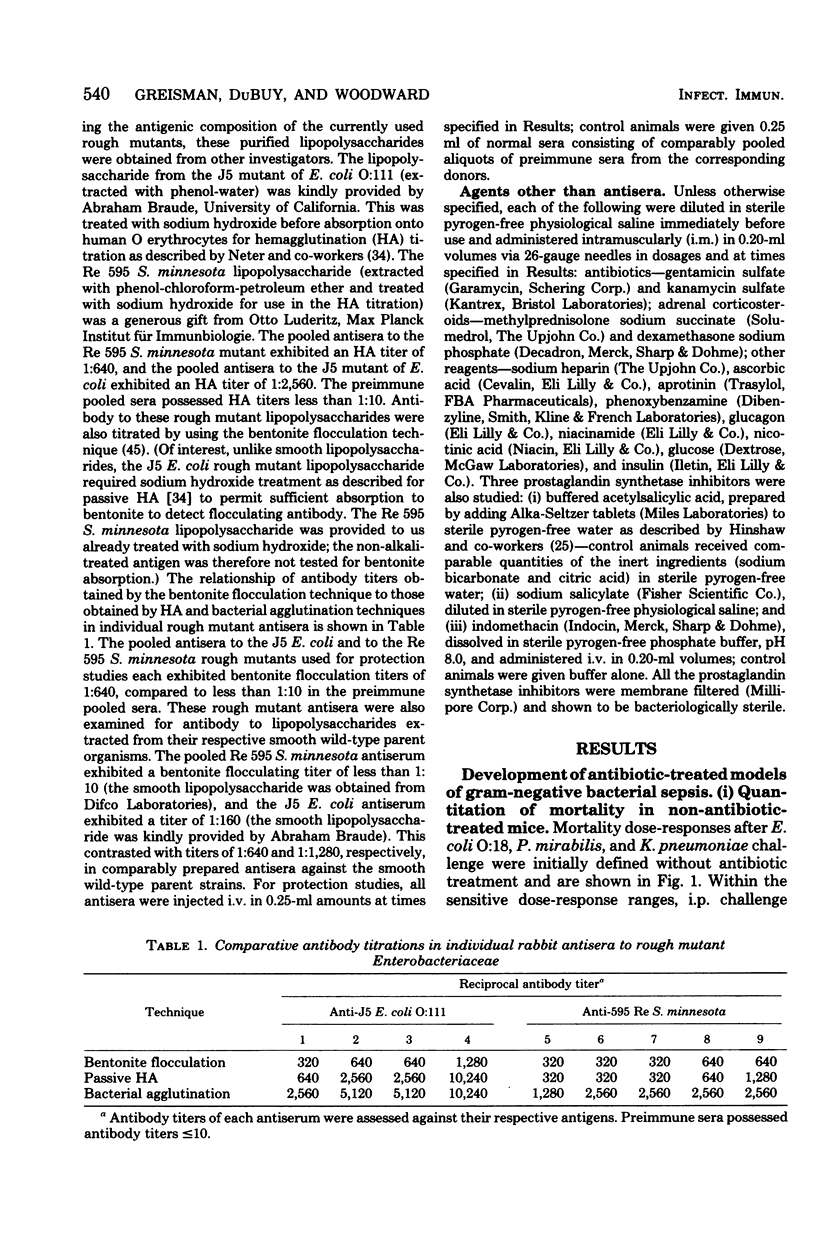







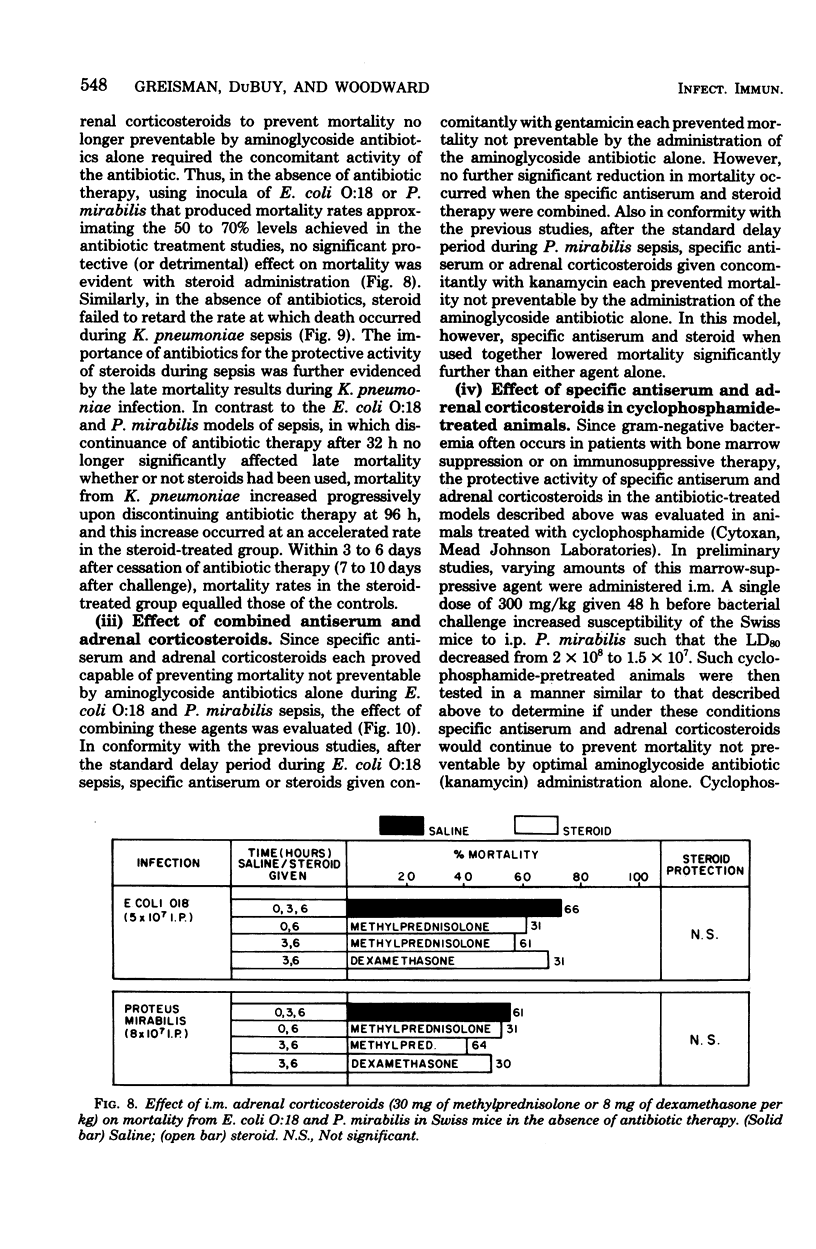
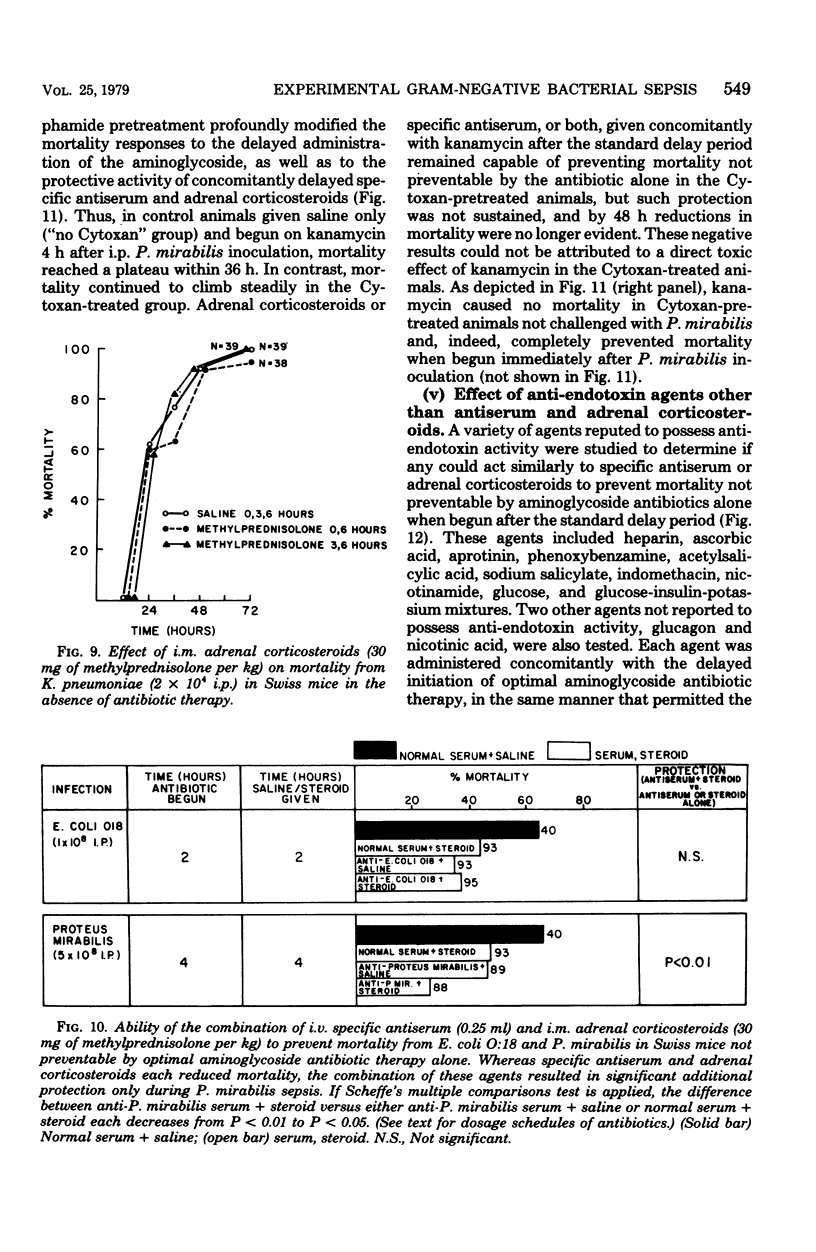

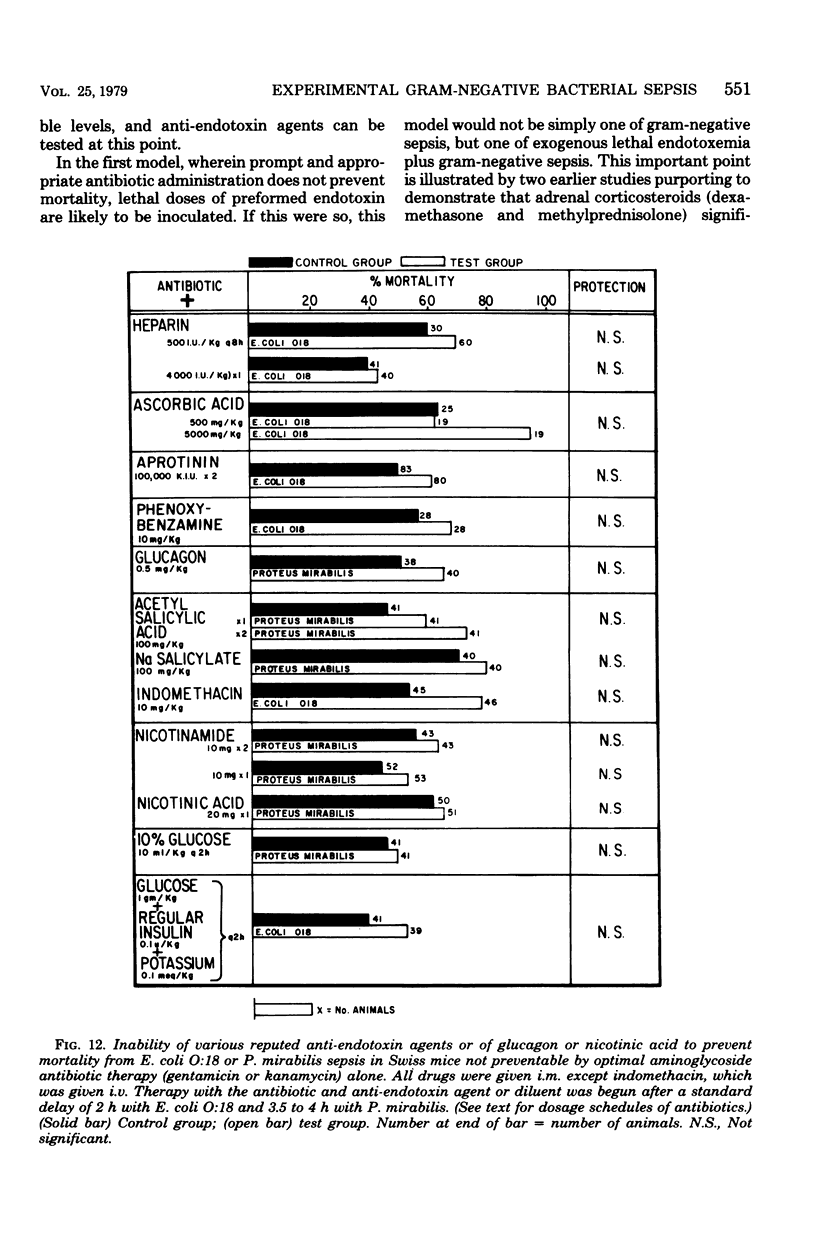


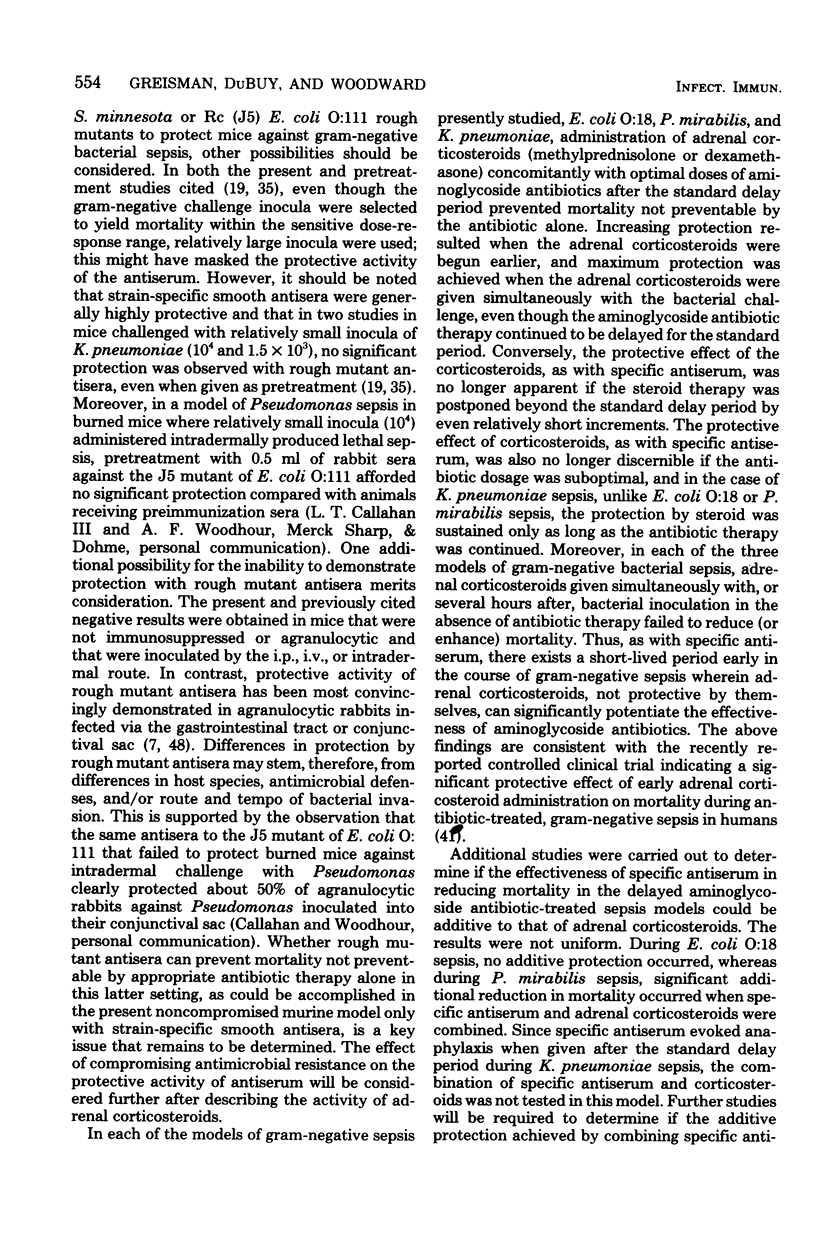



Selected References
These references are in PubMed. This may not be the complete list of references from this article.
- Archer L. T., Beller B. K., Drake J. K., Whitsett T. L., Hinshaw L. B. Reversal of myocardial dysfunction in endotoxin shock with insulin. Can J Physiol Pharmacol. 1978 Feb;56(1):132–138. doi: 10.1139/y78-017. [DOI] [PubMed] [Google Scholar]
- BERRY L. J., SMYTHE D. S. EFFECTS OF BACTERIAL ENDOTOXINS ON METABOLISM. VI. THE ROLE OF TRYPTOPHAN PYRROLASE IN RESPONSE OF MICE TO ENDOTOXIN. J Exp Med. 1963 Oct 1;118:587–603. doi: 10.1084/jem.118.4.587. [DOI] [PMC free article] [PubMed] [Google Scholar]
- BERRY L. J., SMYTHE D. S., YOUNG L. G. Effects of bacterial endotoxin on metabolism. I. Carbohydrate depletion and the protective role of cortisone. J Exp Med. 1959 Sep 1;110:389–405. doi: 10.1084/jem.110.3.389. [DOI] [PMC free article] [PubMed] [Google Scholar]
- BOYER F., CHEDID L. La cortisone dans les infections expérimentales de la souris. Ann Inst Pasteur (Paris) 1953 Feb;84(2):453–457. [PubMed] [Google Scholar]
- Balis J. U., Paterson J. F., Shelley S. A., Larson C. H., Fareed J., Gerber L. I. Glucocorticoid and antibiotic effects on hepatic microcirculation and associated host responses in lethal gram-negative bacteremia. Lab Invest. 1979 Jan;40(1):55–65. [PubMed] [Google Scholar]
- Berk J. L., Hagen J. F., Beyer W. H., Gerber M. J. Hypoglycemia of shock. Ann Surg. 1970 Mar;171(3):400–408. doi: 10.1097/00000658-197003000-00013. [DOI] [PMC free article] [PubMed] [Google Scholar]
- Chedid L., Parant M., Parant F., Boyer F. A proposed mechanism for natural immunity to enterobacterial pathogens. J Immunol. 1968 Feb;100(2):292–306. [PubMed] [Google Scholar]
- Corrigan J. J., Jr, Kiernat J. F. Effect of heparin in experimental gram-negative septicemia. J Infect Dis. 1975 Feb;131(2):138–143. doi: 10.1093/infdis/131.2.138. [DOI] [PubMed] [Google Scholar]
- Davis C. E., Brown K. R., Douglas H., Tate W. J., 3rd, Braude A. I. Prevention of death from endotoxin with antisera. I. The risk of fatal anaphylaxis to endotoxin. J Immunol. 1969 Mar;102(3):563–572. [PubMed] [Google Scholar]
- FREEDMAN H. H. Passive transfer of protection against lethality of homologous heterologous endotoxins. Proc Soc Exp Biol Med. 1959 Nov;102:504–506. doi: 10.3181/00379727-102-25296. [DOI] [PubMed] [Google Scholar]
- FUKUDA T., KOYAMA T. PREVENTION BY ASCORBIC ACID OF LIVER GLYCOGEN DEPLETION IN ENDOTOXIN INTOXICATION. Nature. 1963 Dec 28;200:1327–1327. doi: 10.1038/2001327a0. [DOI] [PubMed] [Google Scholar]
- Filkins J. P., Di Luzio N. R. Heparin protection in endotoxin shock. Am J Physiol. 1968 May;214(5):1074–1077. doi: 10.1152/ajplegacy.1968.214.5.1074. [DOI] [PubMed] [Google Scholar]
- Fletcher J. R., Herman C. M., Ramwell P. W. Improved survival in endotoxemia with aspirin and indomethacin pretreatment. Surg Forum. 1976;27(62):11–12. [PubMed] [Google Scholar]
- GANS H., KRIVIT W. Effect of endotoxin shock on the clotting mechanism of dogs. Ann Surg. 1960 Jul;152:69–76. doi: 10.1097/00000658-196007000-00011. [DOI] [PMC free article] [PubMed] [Google Scholar]
- Greisman S. E., DuBuy J. B., Woodward C. L. Experimental gram-negative bacterial sepsis: reevaluation of the ability of rough mutant antisera to protect mice. Proc Soc Exp Biol Med. 1978 Jul;158(3):482–490. doi: 10.3181/00379727-158-40231. [DOI] [PubMed] [Google Scholar]
- Greisman S. E., Young E. J., DuBuy B. Mechanisms of endotoxin tolerance. 8. Specificity of serum transfer. J Immunol. 1973 Nov;111(5):1349–1360. [PubMed] [Google Scholar]
- HARDAWAY R. M., HUSNI E. A., GEEVER E. F., NOYESHE, BURNS J. W. Endotoxin shock. A manifestation of intravascular coagulation. Ann Surg. 1961 Nov;154:791–802. doi: 10.1097/00000658-196111000-00003. [DOI] [PMC free article] [PubMed] [Google Scholar]
- HUNT G. A., MOSES A. J. Kanamycin treatment of experimental infections in mice. Ann N Y Acad Sci. 1958 Sep 30;76(2):81–87. doi: 10.1111/j.1749-6632.1958.tb54694.x. [DOI] [PubMed] [Google Scholar]
- Harvath L., Andersen B. R., Amirault H. J. Passive immunity against pseudomonas sepsis during granulocytopenia. Infect Immun. 1976 Nov;14(5):1151–1155. doi: 10.1128/iai.14.5.1151-1155.1976. [DOI] [PMC free article] [PubMed] [Google Scholar]
- Hinshaw L. B., Archer L. T., Benjamin B., Bridges C. Effects of glucose or insulin on myocardial performance in endotoxin shock. Proc Soc Exp Biol Med. 1976 Sep;152(4):529–534. doi: 10.3181/00379727-152-39433. [DOI] [PubMed] [Google Scholar]
- Hinshaw L. B., Peyton M. D., Archer L. T., Black M. R., Coalson J. J., Greenfield L. J. Prevention of death in endotoxin shock by glucose administration. Surg Gynecol Obstet. 1974 Dec;139(6):851–859. [PubMed] [Google Scholar]
- Hinshaw L. B., Solomon L. A., Erdös E. G., Reins D. A., Gunter B. J. Effects of acetylsalicylic acid on the canine response to endotoxin. J Pharmacol Exp Ther. 1967 Sep;157(3):665–671. [PubMed] [Google Scholar]
- KASS E. H., KENDRICK M. I., LEVITIN H. Effect of route of administration on protective action of corticosterone and cortisol against endotoxin. Proc Soc Exp Biol Med. 1956 Nov;93(2):306–309. doi: 10.3181/00379727-93-22739. [DOI] [PubMed] [Google Scholar]
- Kazmierowski J. A., Reynolds H. Y., Kauffman J. C., Durbin W. A., Graw R. G., Jr, Devlin H. B. Experimental pneumonia due to Pseudomonas aeruginosa in leukopenic dogs: prolongation of survival by combined treatment with passive antibody to Pseudomonas and granulocyte transfusions. J Infect Dis. 1977 Mar;135(3):438–446. doi: 10.1093/infdis/135.3.438. [DOI] [PubMed] [Google Scholar]
- Lazar G., Agarwal M. K. Influence of oral glucose feeding on endotoxin lethality in mice. Experientia. 1977 Oct 15;33(10):1359–1360. doi: 10.1007/BF01920180. [DOI] [PubMed] [Google Scholar]
- Manny J., Rabinovici N., Manny N., Schiller M., Hechtman H. B. Effect of glucose-insulin-postassium on survival in experimental endotoxic shock. Surg Gynecol Obstet. 1978 Sep;147(3):405–409. [PubMed] [Google Scholar]
- Margaretten W., McKay D. G., Phillips L. L. The effect of heparin on endotoxin shock in the rat. Am J Pathol. 1967 Jul;51(1):61–68. [PMC free article] [PubMed] [Google Scholar]
- McCabe W. R. Immunization with R mutants of S. Minnesota. I. Protection against challenge with heterologous gram-negative bacilli. J Immunol. 1972 Mar;108(3):601–610. [PubMed] [Google Scholar]
- Mills L. C. Corticosteroids in endotoxic shock. Proc Soc Exp Biol Med. 1971 Nov;138(2):507–511. doi: 10.3181/00379727-138-35928. [DOI] [PubMed] [Google Scholar]
- NETER E., WESTPHAL O., LUDERITZ O., GORZYNSKI E. A., EICHENBERGER E. Studies of enterobacterial lipopolysaccharides; effects of heat and chemicals on erythrocyte-modifying, antigenic, toxic and pyrogenic properties. J Immunol. 1956 May;76(5):377–385. [PubMed] [Google Scholar]
- Ng A. K., Chen C. L., Chang C. M., Nowotny A. Relationship of structure to function in bacterial endotoxins: serologically cross-reactive components and their effect on protection of mice against some gram-negative infections. J Gen Microbiol. 1976 May;94(1):107–116. doi: 10.1099/00221287-94-1-107. [DOI] [PubMed] [Google Scholar]
- Palmerio C., Nahor A., Minton R., Fine J. Limitations of antiadrenergic therapy for refractory traumatic shock. Proc Soc Exp Biol Med. 1967 Feb;124(2):623–627. doi: 10.3181/00379727-124-31808. [DOI] [PubMed] [Google Scholar]
- Pitcairn M., Schuler J., Erve P. R., Holtzman S., Schumer W. Glucocorticoid and antibiotic effect on experimental gram-negative bacteremic shock. Arch Surg. 1975 Aug;110(8):1012–1015. doi: 10.1001/archsurg.1975.01360140156030. [DOI] [PubMed] [Google Scholar]
- Priano L. L., Wilson R. D., Traber D. L. Lack of significant protection afforded by heparin during endotoxic shock. Am J Physiol. 1971 Apr;220(4):901–905. doi: 10.1152/ajplegacy.1971.220.4.901. [DOI] [PubMed] [Google Scholar]
- Radvany R., Neale N. L., Nowotny A. Relation of structure to function in bacterial O-antigens. VI. Neutralization of endotoxic O-antigens by homologous O-antibody. Ann N Y Acad Sci. 1966 Jun 30;133(2):763–786. doi: 10.1111/j.1749-6632.1966.tb52404.x. [DOI] [PubMed] [Google Scholar]
- Robson H. G., Cluff L. E. Experimental pneumococcal and staphylococcal sepsis: effects of hydrocortisone and phenoxybenzamine upon mortality rates. J Clin Invest. 1966 Sep;45(9):1421–1432. doi: 10.1172/JCI105450. [DOI] [PMC free article] [PubMed] [Google Scholar]
- Schumer W. Steroids in the treatment of clinical septic shock. Ann Surg. 1976 Sep;184(3):333–341. doi: 10.1097/00000658-197609000-00011. [DOI] [PMC free article] [PubMed] [Google Scholar]
- Shaw R. C., Holzer M. E., Venzon D., Ullman R., Butcher H. R., Jr, Moyer C. A. A bioassay of treatment of hemorrhagic shock. 3. Effects of a saline solution, ascorbic acid, and nicotinamide upon the toxicity of endotoxin for rats. Arch Surg. 1966 Oct;93(4):562–566. doi: 10.1001/archsurg.1966.01330040026003. [DOI] [PubMed] [Google Scholar]
- Thomas C. S., Jr, Brockman S. K. The role of adrenal corticosteroid therapy in Escherichia coli endotoxin shock. Surg Gynecol Obstet. 1968 Jan;126(1):61–69. [PubMed] [Google Scholar]
- WOLFF S. M., WARD S. B., LANDY M. SEROLOGIC PROPERTIES OF BENTONITE PARTICLES COATED WITH MICROBIAL POLYSACCHARIDES. Proc Soc Exp Biol Med. 1963 Nov;114:530–536. doi: 10.3181/00379727-114-28724. [DOI] [PubMed] [Google Scholar]
- Waitz J. A., Weinstein M. J. Recent microbiological studies with gentamicin. J Infect Dis. 1969 Apr-May;119(4):355–360. doi: 10.1093/infdis/119.4-5.355. [DOI] [PubMed] [Google Scholar]
- Young L. S., Stevens P., Ingram J. Functional role of antibody against "core" glycolipid of Enterobacteriaceae. J Clin Invest. 1975 Oct;56(4):850–861. doi: 10.1172/JCI108164. [DOI] [PMC free article] [PubMed] [Google Scholar]
- Ziegler E. J., Douglas H., Braude A. I. Human antiserum for prevention of the local shwartzman reaction and death from bacterial lipopolysaccharides. J Clin Invest. 1973 Dec;52(12):3236–3238. doi: 10.1172/JCI107524. [DOI] [PMC free article] [PubMed] [Google Scholar]
- Ziegler E. J., Douglas H., Sherman J. E., Davis C. E., Braude A. I. Treatment of E. coli and klebsiella bacteremia in agranulocytic animals with antiserum to a UDP-gal epimerase-deficient mutant. J Immunol. 1973 Aug;111(2):433–438. [PubMed] [Google Scholar]


